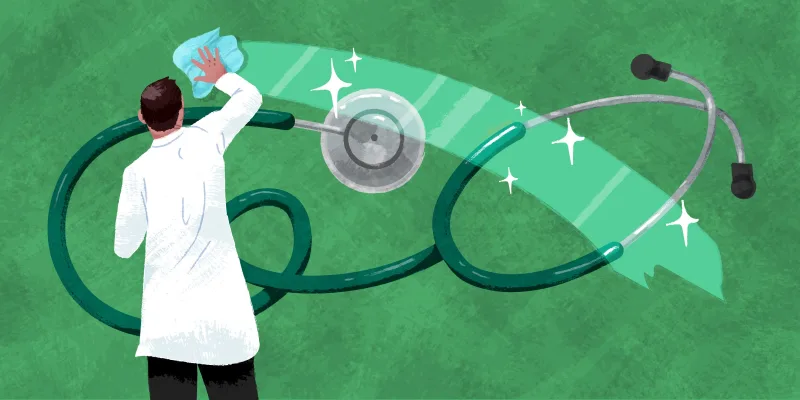Sam arrived late one night as a transfer from a regional hospital for evaluation of a malfunctioning dialysis access graft. Except in emergencies, I generally review as much information as I can from the available EMR and paper chart before I see a new patient. In Sam’s case, the prior documentation had all sorts of descriptions: "30-year-old African American male," "transgender female," "transperson," with inconsistent usage of pronouns, sometimes "he," sometimes "she," sometimes "they."
Although I did not anticipate that the patient's gender identity would impact my clinical plan, I was aware that transgender patients experience barriers and judgments when accessing health care. I reminded myself to avoid assumptions. I had also recently discovered that where one normally edits a patient's demographics in the EMR, there was a new panel to add patient identity preferences, including preferred names, pronouns, and gender and sexual identity. I was eager to correct the system so that this patient could potentially avoid the damaging misgendering already present throughout their chart documentation.
When I entered the room, I found Sam already tucked in the patient bed, watching television. I introduced myself, and then asked what their preferred name was, which turned out to be the name as documented in the chart. I also asked if they identified as female or male or neither, and requested their preferred pronouns. Sam answered me, but in as few words as possible, with an intense stare as if they were suspicious of me. I asked the remainder of my medical history questions, examined the dialysis graft in their arm, explained the care plan moving forward, and asked if there was anything else I could do for them. It was only then, at the end of the encounter, that Sam finally smiled, declined everything, and thanked me for seeing them.
Outside the room, I drafted my note, and updated the identity demographics. Feeling quite pleased, I closed the patient chart to move on to the next patient and happened to glance at the patient list on the home screen. My patient list has columns containing abbreviated information — things like room number, name, medical record number, as well as age and sex. I saw that even though I had specifically chosen a "gender" identity, the abbreviation on my list had changed Sam’s sex from M to F. I panicked, reopened the chart, and deleted my entry in the gender box. The chart reverted back to the documented sex, which was M.
Why did I panic? I mulled this over for the rest of the night and for days after. Sex and gender are different things, but the discrepancy in definition was not why I was concerned. For a patient’s usual care team, it's easy to remember that the abbreviation on the main list reflects a gender identity — but if something emergent happens, and a clinician who is not familiar with the patient (like the code team or stroke team) arrives to provide care, will they mistake gender identity for physiologic sex? And are there actual situations where it will make a clinical difference?
"There's nothing we would change medically in a cardiopulmonary resuscitation," says Dr. Doug Schiller, DO, one of our clinicians in the cardiac ICU. He is double board certified in EM and critical care medicine, and works in the ED as well. For situations in which there is truly no time to delve into a patient's chart or ask the patient for information — e.g., during a cardiac arrest, respiratory arrest, et cetera — there are not separate protocols or considerations for a male versus a female patient. However, Dr. Schiller pointed out that when it comes time to talk to the patient's family or significant other, the use of an incorrect pronoun can spotlight discrepancies. Exposure of trans identity, for instance, may put the patient at risk of discrimination from others, be it from member of the care team or family and friends. In sum, misgendering can have numerous negative effects on the patient, which can lead to reluctance in the future to seek care.
Of course, this is not to suggest there aren't times when transgender status is clinically relevant, but they tend to occur in situations when there is time to go through the chart and/or talk to the patient or patient's family. There may be a higher likelihood, for example, that new onset chest pain and shortness of breath is due to a pulmonary embolism in a patient on estrogen hormone replacement therapy, though the workup for chest pain does not change. Blood counts, electrolytes, and kidney function lab tests may be altered in the setting of hormone-modulating medications. Repair of traumatic injuries must take into account local anatomic changes or implant rupture in patients who have had gender-affirming surgery, especially given the higher likelihood of assault as a cause of traumatic injuries in transgender populations.
I feel better now about the improved functionality to update gender identity in the EMR. It is absolutely necessary that this information be available and accurate, not only for non-emergency clinical reasons, but also for inclusivity toward this special patient population. That said, there is much that can still be improved upon, as evidenced by the system’s inability to separate sex/gender on my patient list. The EHR also does not currently include an abbreviation to identify non-binary preferences.
Education and awareness on these issues, and on the art of establishing the patient rapport and trust required to obtain this information, are lacking. At the last national conference Dr. Schiller attended for EM doctors, he recalls that there were not any educational opportunities on the subject. This is a gap that will need to be filled if we are to provide the best care for transgender patients — not just for trainees in medical school and residency, but also for practicing clinicians as part of their continuing medical education.
Are there changes or updates you would make to the EHR to improve care for particular patient populations? Share your suggestions in the comments.
Scarlett Hao is a PGY-4 resident in general surgery at East Carolina University / Vidant Medical Center. She graduated from University of Maryland School of Medicine. She is pursuing a career in academic medicine and surgical oncology. Scarlett is a 2020–2021 Doximity Op-Med Fellow.
All names and identifying information have been modified to protect patient privacy.
A special thanks to Dr. Doug Schiller for sharing his thoughts for this piece.







